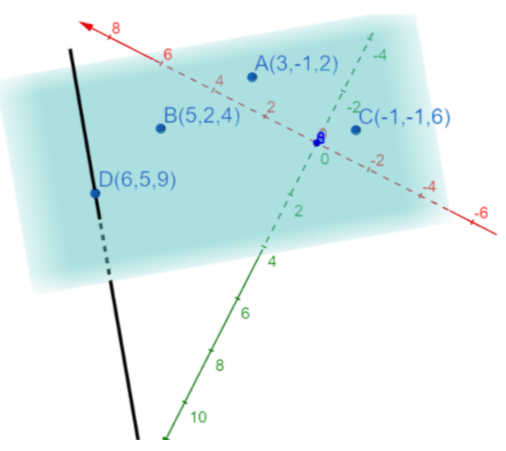Question
Question: Find the vector equation of the plane determined by the points \(A\left( 3,-1,2 \right)\), \(B\left(...
Find the vector equation of the plane determined by the points A(3,−1,2), B(5,2,4) and C(−1,−1,6). Also find the distance of point P(6,5,9) from this plane.
Solution
We start solving the problem by checking whether the given three-point are non-collinear or not. If the points are not collinear, we find the equation of the plane using these three points. Once we find the equation of the plane, we find the distance of the point from the plane.
Complete step-by-step solution:
Given that we have three points A(3,−1,2), B(5,2,4) and C(−1,−1,6). We need to find the vector equation of the plane and the distance of the point P(6,5,9) from this plane.
Let us draw all the given information to get a better view.

To find the equation of the plane containing three points, we first need to make sure that the three points are not collinear.
We know if three points (x1,y1,z1), (x2,y2,z2) and (x3,y3,z3) are said to be collinear, then the condition to be satisfied is x1 x2 x3 y1y2y3z1z2z3=0.
Let us find the value of the determinant 3 5 −1 −12−1246.
We know that the determinant of a 3×3 matrix is defined as a d g behcfi=a×e h fi−b×d g fi+c×d g eh.
⇒3 5 −1 −12−1246=3×2 −1 46−(−1)×5 −1 46+2×5 −1 2−1.
We know that determinant of 2×2 matrix is defined as p r qs=(p×s)−(q×r).
⇒3 5 −1 −12−1246=3×((2×6)−(−1×4))−(−1)×((5×6)−(−1×4))+2×((5×−1)−(−1×2)).
⇒3 5 −1 −12−1246=3×((12)−(−4))−(−1)×((30)−(−4))+2×((−5)−(−2)).
⇒3 5 −1 −12−1246=3×(12+4)−(−1)×(30+4)+2×(−5+2).
⇒3 5 −1 −12−1246=3×(16)+1×(34)+2×(−3).
⇒3 5 −1 −12−1246=48+34−6.
⇒3 5 −1 −12−1246=76.
So, the points A(3,−1,2), B(5,2,4) and C(−1,−1,6) are not collinear.
We know that the equation of the plane containing three non- collinear points (x1,y1,z1), (x2,y2,z2) and (x3,y3,z3) is x−x1 x2−x1 x3−x1 y−y1y2−y1y3−y1z−z1z2−z1z3−z1=0.
Now, we find the equation of the plane containing the points A(3,−1,2), B(5,2,4) and C(−1,−1,6).
The equation of the required plane is x−3 5−3 −1−3 y−(−1)2−(−1)−1−(−1)z−24−26−2=0.
